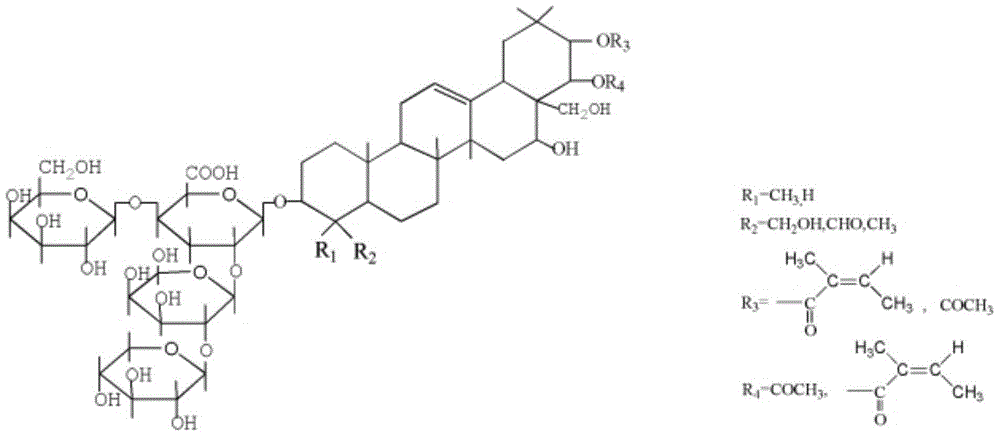Environment-friendly tertiary oil recovery oil-displacing agent based on biosurfactant
A technology of co-surfactant and biological surface, applied in the direction of drilling compositions, chemical instruments and methods, etc., can solve the problems of high production raw material cost, poor degradation performance, waste of resources, etc., and achieve consumption saving and oil displacement efficiency The effect of increasing and reducing the cost of raw materials
- Summary
- Abstract
- Description
- Claims
- Application Information
AI Technical Summary
Problems solved by technology
Method used
Image
Examples
Embodiment 1
[0032] Take by weighing the subtilisin sodium of 0.6 weight part, the alkylbenzene sulfonate of 35 weight parts, the amide type betaine of 8 weight parts and the tea saponin modifying agent of 2 weight parts add in the reactor and mix, then Add 1.2 parts by weight of co-surfactant and 65 parts by weight of water and stir until uniform to prepare an oil displacing agent.
[0033] The oil displacement agent prepared above was added to the groundwater and crude oil mixture that simulated the oil production conditions of a block in Karamay Oilfield, Xinjiang, and the interfacial tension between crude oil / formation water and the recovery rate were measured. The mass concentration of the oil displacement agent was measured to be 0.0462 g / L, the interfacial tension between crude oil / formation water is 1.32×10 -3 mN / m, the oil recovery rate is 16.3%, and the oil displacement agent separated by demulsification in crude oil recovery can be degraded.
Embodiment 2
[0035] Take by weighing 0.8 parts by weight of subtilisin sodium, 30 parts by weight of alkylbenzene sulfonate, 10 parts by weight of amido betaine and 1.6 parts by weight of tea saponin modifier and add in the reactor and mix evenly, then Add 1.4 parts by weight of co-surfactant and 57 parts by weight of water and stir until uniform to prepare an oil displacing agent.
[0036] The oil displacement agent prepared above was added to the groundwater and crude oil mixture that simulated the oil production conditions of a block in Karamay Oilfield, Xinjiang, and the interfacial tension between crude oil / formation water and the recovery rate were measured. The mass concentration of the oil displacement agent was measured to be 0.0358 At g / L, the interfacial tension between crude oil / formation water is 1.75×10 -3 mN / m, the oil recovery rate is 15.4%, and the oil displacement agent demulsified and separated in crude oil recovery can be degraded.
Embodiment 3
[0038] Take by weighing 1.0 parts by weight of lipopeptide sodium, 25 parts by weight of alkylbenzene sulfonate, 12 parts by weight of amido betaine and 1.5 parts by weight of tea saponin modifier and add in the reactor and mix evenly, then Add 1.5 parts by weight of co-surfactant and 50 parts by weight of water and stir until uniform to prepare an oil displacing agent.
[0039] The oil displacement agent prepared above was added to the groundwater and crude oil mixture that simulated the oil production conditions of a block in Karamay Oilfield, Xinjiang, and the interfacial tension between crude oil / formation water and the recovery rate were measured. The mass concentration of the oil displacement agent was measured to be 0.028 At g / L, the interfacial tension between crude oil / formation water is 1.9×10 -3 mN / m, the oil recovery rate is 14.8%, and the oil displacement agent for oil recovery and demulsification separation can be degraded and environmentally friendly.
PUM
 Login to View More
Login to View More Abstract
Description
Claims
Application Information
 Login to View More
Login to View More - R&D
- Intellectual Property
- Life Sciences
- Materials
- Tech Scout
- Unparalleled Data Quality
- Higher Quality Content
- 60% Fewer Hallucinations
Browse by: Latest US Patents, China's latest patents, Technical Efficacy Thesaurus, Application Domain, Technology Topic, Popular Technical Reports.
© 2025 PatSnap. All rights reserved.Legal|Privacy policy|Modern Slavery Act Transparency Statement|Sitemap|About US| Contact US: help@patsnap.com



